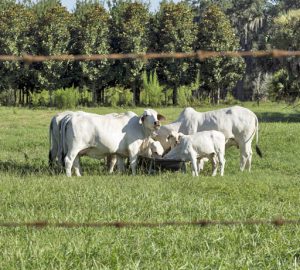Here are some tips for determining winter forage needs of the cow herd.
Forage species, fertilization program, growing conditions, forage maturity, and harvest management all interact to affect forage quality.
Producers often estimate hay needs for their beef cow herd based on rules of thumb and neighbor’s advice. This may not be accurate for their individual operation. One common approach is to allow two round rolls of hay for every cow to be supplemented during the winter. While this may get a producer started, it is not accurate and likely may result in not enough hay. Likewise there can be extensive variability of conserved forage quality as a result of forage type, maturity, fertilization, growing conditions, and hay vs. balage. The focus of this fact sheet is to provide a simple approach for estimating dry matter feed requirements of the beef herd and then converting those requirements into an estimate of required hay or silage round rolls.

Nutritional quality of conserved forages can be described by a variety of terms and methods and can be highly variable even when all other factors appear constant. Forage species, fertilization program, growing conditions, forage maturity, and harvest management all interact to affect forage quality. It is assumed that the nutritional quality of the feedstuffs (i.e., stored forages) is adequate for meeting the daily requirements of the herd. Additional supplementation may be required if the forage quality is low or the livestock requirements exceed the nutritional value of the harvested forages.
Dry matter content is the portion of feed remaining when all of the moisture is removed. Hay probes for measuring bale moisture can be used to make an estimation of moisture; however, the results are only marginally accurate. Submitting a sample to a forage testing laboratory is the best approach for measuring moisture content. In addition to moisture, the test will also provide important nutritional information. Different production lots should be sampled independently for both physical and nutritional parameters.
The use of other feedstuffs to supply dry matter and nutrients will affect the accuracy of the predicted required stored forage estimates. Standing forages (either stockpiled or cool season annuals), supplements, and other provided feeds may dramatically reduce the stored forage requirements. The herd requirements haven’t changed, but the nutrient source has.
Ideally, forages would be protected from nutrient losses during storage. For this to be optimal, they would need to be stored out of the elements, primarily sun, rain and dew. This is often not practical. Deviations from optimal storage and feeding can result in dry matter losses over 50%. Keep in mind that the outer six inches of a five-foot-diameter bale is 34% of the total mass and the outer twelve inches is over 60% of a bale weight.
Most bales are marketed based on assumed weights. Large bales are assumed to be over 1,000 pounds, and small bales are assumed to be less than 800 pounds. In a study on storage losses, bale weights were averaged to establish a baseline. All bales came from the same baler, and the dimensions were roughly 4×5 feet. The average weight of the bales was 785 pounds, 215 pounds less than the anticipated 1,000 pounds. Overestimation of bale weight can be a serious issue. The best way to estimate bale weight is by weighing a representative sample utilizing a set of truck scales.
Producers often misjudge the frame size and body weight of their cattle. Keen managers utilize outside data to improve the accuracy of their estimations. Access to a set of scales removes the guess work. Alternatively, purchasing records, sale weights of culled cattle, or an unbiased expert may help. Once weight averages are determined, the frame score can be used to place cattle into the small, medium, or large frame category. Be sure that averages are really herd averages by collecting data on a large number of individuals (25 to 33% of the total animals).
With the above mentioned in mind, producers can make more accurate estimations of how much stored forage their cow herds will need for the winter supplementation period. For assistance and more information, contact your local UF-IFAS County Extension Office.
If you have any pasture or livestock questions relating to Levy County please feel free to contact Ed Jennings, UF/IFAS Extension Director for Levy County at (352) 486-5131 or by email at edjennin@ufl.edu.
To see the 2017 Cool-Season Forage Variety Recommendations for Florida, click here.
 0
0

Comments are closed.